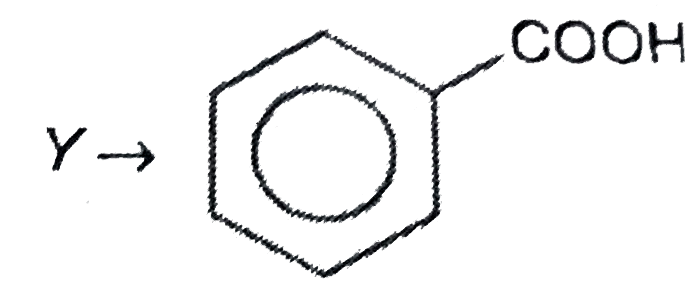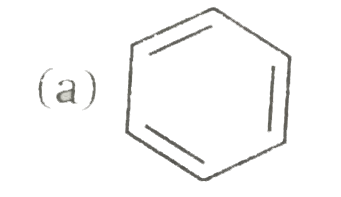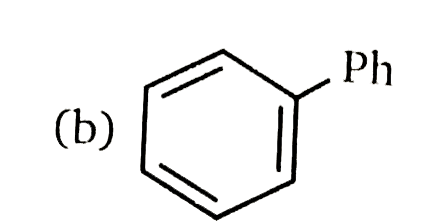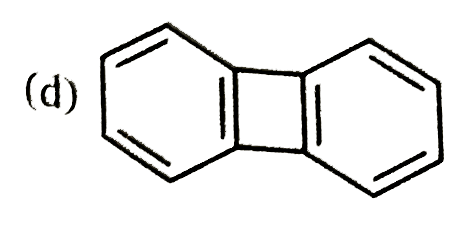An organic compound (A) with molecular formula C8H8O forms an orange red precipitate with 2,4 -DNP reagent and gives yellow precipitate on heating with iodine in the presence of sodium hydroxide . It neither reduces Tollen's reagent or Fehling's solution , nor does it decolourise bromine water or Baeyer's reagent. On drastic oxidation with chromic acid, it gives a carboxylic acid (B) having molecular formulae C7H6O2. Identify the compound (A) and (B) and explain the reactions involved .
Step-1. To determine the structures of compounds (A) and (B).
(i) Since compound (A), M.F. C8H8O forms a 2,4-DNP, it must be either an aldehyde or a ketone.
(ii) Since, it does not reduce tollens' reagent or Fehling's solution, (A) is must be a ketone.
(iii) Since (A) on treatment with I2/NaOH, gives yellow ppt. (iodoform), therefore, it must be a methyl ketone.
(iv) D.B.E. for C8H8O=8(4−2)+8(1−2)+1(2−2)2+1=5
One of the five sites of unsaturation must be due to the keto group, the remaining four may be due to the presence of a benzene ring. the presence of benzene ring is supported by the observation that it neither decolourizes bromine water nor Baeyer's reagent.
(v) Since drastic oxidatio of A with chromic acid gives compound (B) with M.F. C7H6O2, therefore, (B) must be benzoic acid. further, the formation of benzoic acid suggests that compound (A) is a mono-substituted benzene derivative.
(vi) Thus, compound (A) has a monosubstituted benzene ring, i.e., a C6H5 ring CH3CO group. both these group account for the complete M.F. (C6H5+COCH3=C8H8O) of compound (A), therefore, compound (A) is acetophenone or methyl phenyl ketone or 1-phenylethanone.

Step.2: To explain all the reactions involved in the question.

Topper's Solved these Questions
- BOOK - PRADEEPCHAPTER - ALDEHYDES, KETONES AND CARBOXYLIC ACIDS EXERCISE - NCERT QUESTIONS AND EXERCISES WITH ANSWERS (NCERT INTEXT UNSOLVED QUESTIONS)8videos
ALDEHYDES, KETONES AND CARBOXYLIC ACIDS
- BOOK - PRADEEPCHAPTER - ALDEHYDES, KETONES AND CARBOXYLIC ACIDS EXERCISE - NCERT EXERCISES20videos
ALDEHYDES, KETONES AND CARBOXYLIC ACIDS
- BOOK - PRADEEPCHAPTER - ALDEHYDES, KETONES AND CARBOXYLIC ACIDS EXERCISE - CONCEPTUAL QUESTIONS19videos
ALDEHYDES, KETONES AND CARBOXYLIC ACIDS
- BOOK - PRADEEPCHAPTER - ALCOHOLS, PHENOLS AND ETHERSEXERCISE - IMPORTANT QUESTIONS FOR BOARD EXAMINATIONS.29videos
ALCOHOLS, PHENOLS AND ETHERS
- BOOK - PRADEEPCHAPTER - APPENDIXEXERCISE - MODEL TEST PAPER <br> (Section C )15videos
APPENDIX
Similar Questions
Compound which forms an orange red precipitate with 2, 4 - DNP reagent and gives yellow precipitate on heating with iodine in the presence of sodium hydroxide is
View SolutionAn organic compound (A) with molecular formula C8H8O forms an orange red precipitate with 2,4 -DNP reagent and gives yellow precipitate on heating with iodine in the presence of sodium hydroxide . It neither reduces Tollen's reagent or Fehling's solution , nor does it decolourise bromine water or Baeyer's reagent. On drastic oxidation with chromic acid, it gives a carboxylic acid (B) having molecular formulae C7H6O2. Identify the compound (A) and (B) and explain the reactions involved .
View Solution
Knowledge Check
- Question 1 - Select One
An organic compound (A) with molecular formula C8H8O forms an orange red precipitate with 2,4 -DNP reagent and gives yellow precipitate on heating with iodine in the presence of sodium hydroxide . It neither reduces Tollen's reagent or Fehling's solution , nor does it decolourise bromine water or Baeyer's reagent. On drastic oxidation with chromic acid, it gives a carboxylic acid (B) having molecular formulae C7H6O2. Identify the compound (A) and (B) and explain the reactions involved .
A B
B C
C D
D
- Question 2 - Select One
Which of the following can reduce Tollen's reagent but not Fehling solution ?
AC6H5CHOBCH3CHOCC3H7CHODCH3COCH3 - Question 3 - Select One
An organic compound 'P' with jmolecular formula C8H8O forms an organic red ppt with 2,4−DNP gives yellow ppt. on heating with I2 in presence of NaOH. It neither reduces tollen's or fehling reagent nor does it decolourise Br2 water or baeyer's reagent. On drastic oxidation with chromic acid (H2CrO4) it gives an acid (Q) having molecular formula C7H6O2.
Q. QNaOH/CaO/Δ−−−−−−−−−−→R (Major product).
R will be,A B
B C
C D
D
An organic compound [A] with molecular formula C9H10O forms an arage-red precipitate [B] with 2,4 DNP reagent. Compound [A] gives yellow precipiatate [C] on heating wihth iodine in the presence of soedium hydroxide along with a colourless compound [D]. The compound [A] does not reduce Tollen's reagent or Fehling's solution nor does it decolourise bromine water or Baeyer's reagent. On drastic oxidation with chromic acid, compound [A] gives a crboxylic acid [E] having molecular formula C7H6O2. Deduce the strcutres of the organic compounds [A] to [E].
View SolutionAn organic compound 'P' with jmolecular formula C8H8O forms an organic red ppt with 2,4−DNP gives yellow ppt. on heating with I2 in presence of NaOH. It neither reduces tollen's or fehling reagent nor does it decolourise Br2 water or baeyer's reagent. On drastic oxidation with chromic acid (H2CrO4) it gives an acid (Q) having molecular formula C7H6O2.
Q. Identify compound P:View SolutionAn organic compound A with molecular formula C9H10O gives positive DNP and iodoform tests. It does not reduce. Tollen's reagent or Fehling reagent and does not decolourless bromine water or Bayer's reagent. On drastic oxidation with chronic acid, compound A gives a carboxylic acid having molecular formula C7H6O2. Deduce the structur eof organic compound A and write all the chemical reactions involved.
View SolutionAn organic compound 'P' with jmolecular formula C8H8O forms an organic red ppt with 2,4−DNP gives yellow ppt. on heating with I2 in presence of NaOH. It neither reduces tollen's or fehling reagent nor does it decolourise Br2 water or baeyer's reagent. On drastic oxidation with chromic acid (H2CrO4) it gives an acid (Q) having molecular formula C7H6O2.
Q. Pdil.өOH−−−→ΔSCH3MgBr(1 mole)−−−−−−−−−−−−→H3O⊕
No. of stereoisomer in the final product T:View SolutionGive the reaction of glucose with Tollen's reagent and Fehling's solution.
View Solution

